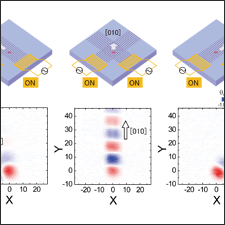Control of electron spin in semiconductors using ultrasonic wave
- One step closer to semiconductor spintronics device -

NTT Basic Research Laboratories has developed a method for measuring the complicated dynamics of electron spins moving in semiconductors and succeeded in manipulating the spins by using an ultrasonic wave for the first time. This achievement accelerates progress in research on semiconductor spintronics and will be applied to spin transistors that operate with ultralow power consumption, as well as quantum computers that enable ultrafast information operation.
The research field called "semiconductor spintronics" is aimed at extracting electronic "spin" as well as their "charge" to use them for both classical and quantum information technologies. The semiconductor spintronics devices require a method of transporting electrons while maintaining their spins and a technique to manipulate the spin directions arbitrarily. NTT Basic Research Laboratories have developed a technology that transfers electrons while maintaining their spin state for a long distance using ultrasonic wave (Fig. 1), by using a method for measuring images of the spatial distribution of the spins that precession during the transport (Fig. 2). From these measurements, we have substantiated that the acoustically induced deformation strain and piezo-electrical field are related to the origin of the spin-orbit interactions (Fig. 3). The previously reported spin-orbit interaction was mainly caused by the internal electrical field induced by the host material or an externally applied electrical field. Our new spin-orbit interaction makes it possible to manipulate the spin by changing the intensity of the ultrasonic wave.
This result was obtained during joint research with Tohoku University and the Paul-Drude-Institute for Solid State Electronics, and published in the electronic edition of Physical Review Letters on May 26. Part of this work was undertaken with support from the Japan Society for the Promotion of Science (JSPS).
=> Quantum Optical Physics Research Group

Fig. 1 Electron spin transfer using an ultrasonic wave (surface acoustic wave)
The surface acoustic wave propagating in a semiconductor quantum well structure generates a periodic wave of potential energy via the piezoelectric effect. The electrons in the quantum well are trapped in the bottoms of the modulated potential and transferred with the surface acoustic wave.

Fig. 2 Spin measurement using the scanning Kerr rotation method
We used the scanning Kerr rotation method for the highly sensitive measurement of the spin dynamics during the transport by ultrasonic waves. Spin precession feature is clearly observed in an actual measurement (bottom graphs) for all three transfer directions.

Fig. 3 Spin manipulation experiment using ultrasonic wave
The spin precession dynamics has been analyzed by changing (a) the spin transfer direction, and (b) the ultrasonic wave intensity. It has been clarified that the strain and electric fields caused by the ultrasonic wave affects the spin-orbit interaction. These facts reveal the possibility of spin manipulation by controlling the ultrasonic wave.










